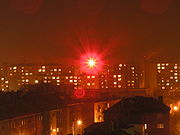In summary, no evidence has been provided that interference between free-space optical systems is a concern. Existing ITU-R Recommendations and Reports, e.g. Report ITU-R F.2106 - 'Fixed service applications using free-space optical links' sufficiently address free-space optical links.
Implementation aspects
Industry is deploying free-space optical systems for different
applications. They provide high security, low cost, low power,
and high transmitting rates. Optical links are suitable for 1–2
Gbits/s rates over distances in the range of 1–5 km.
Some applications use single high-brightness LED with a cheap loupe lens which creates a bright narrow beam that can stream DVD-quality video over neighbourhoods.

